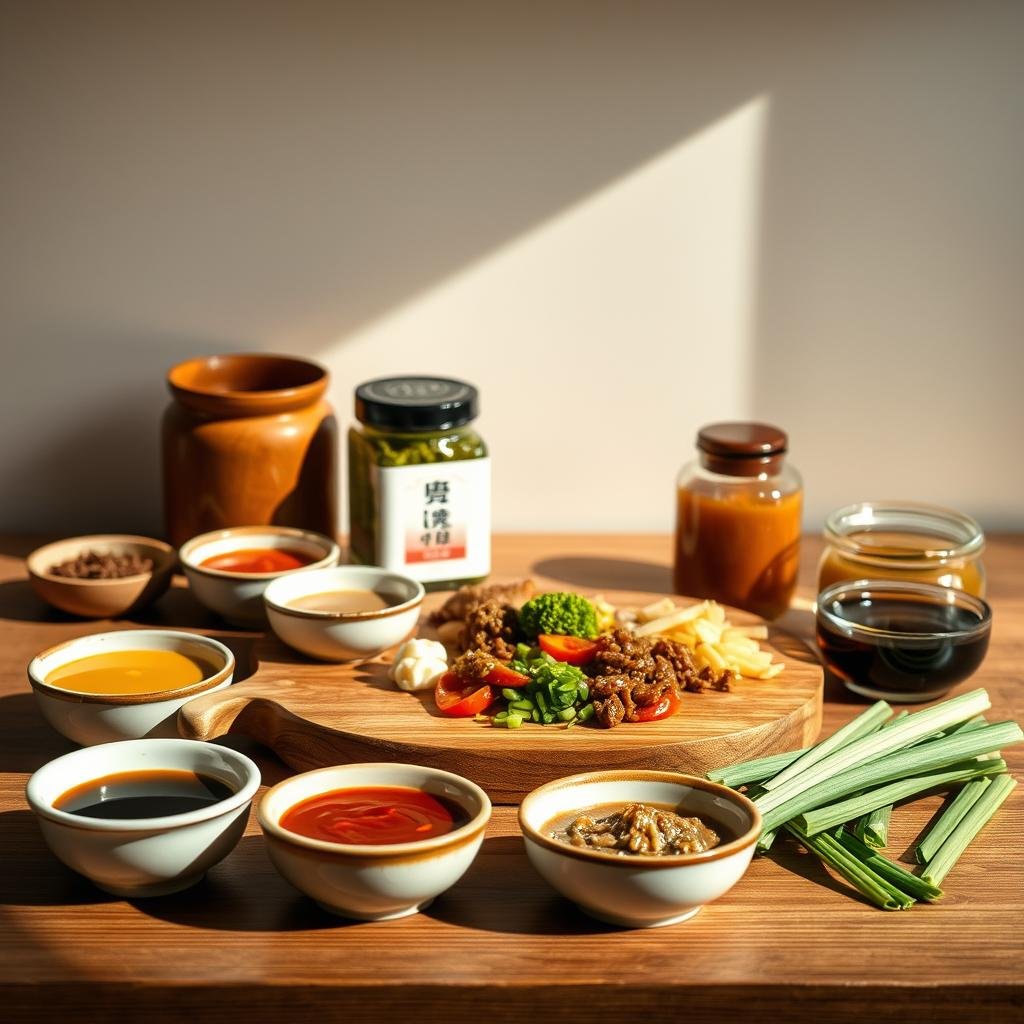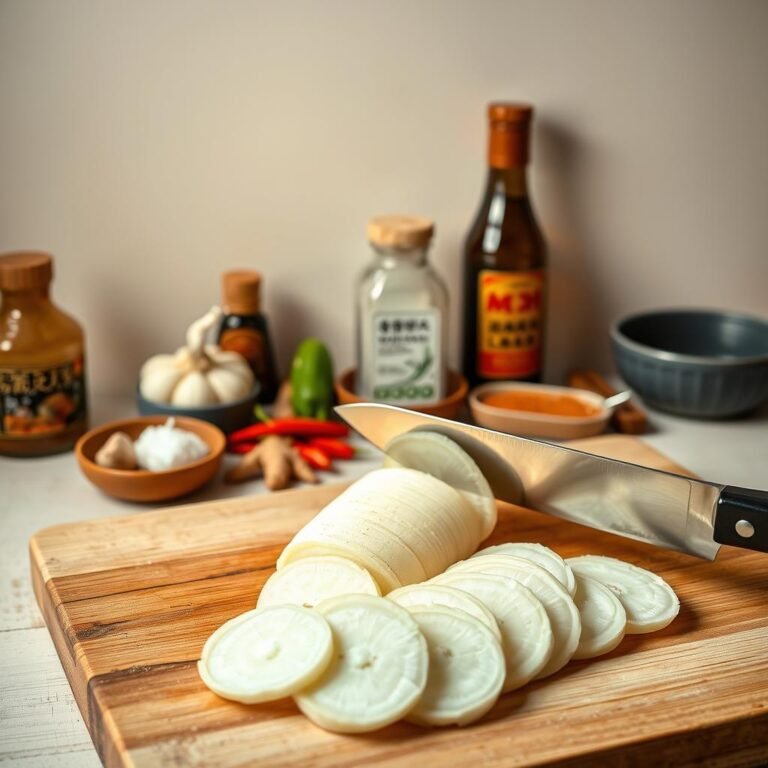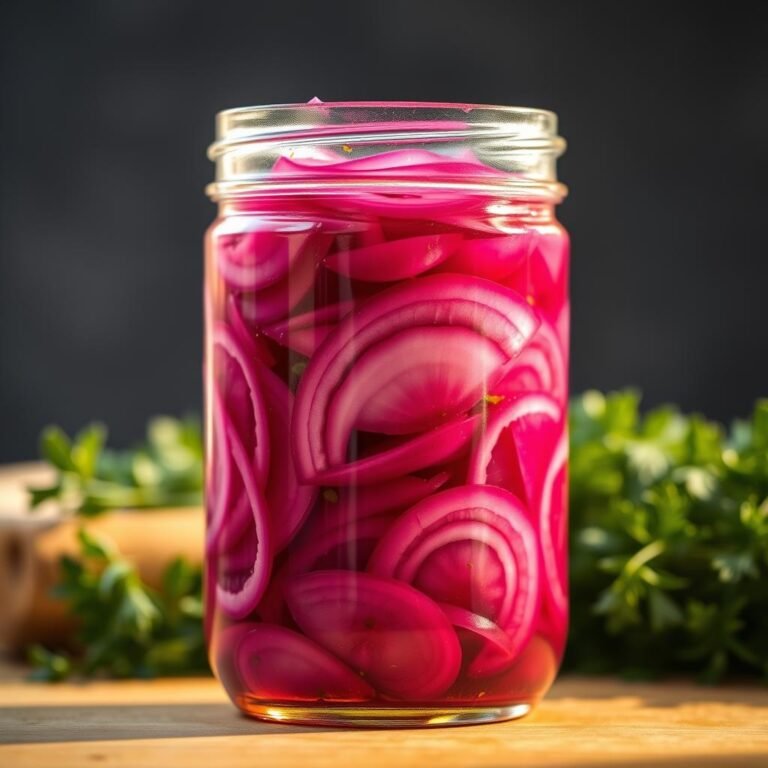How to Make Miso Soup with Paste and its Probiotic Effect

Miso soup is a traditional Japanese dish loved worldwide. It’s known for its rich flavors and health perks. Learning how to make miso soup is a tasty journey. It also introduces you to the probiotic benefits of miso soup.
Miso paste, made from fermented soybeans, is key. It boosts gut health and overall wellness. This article will show you how to make homemade miso soup. We’ll cover its ingredients, how to prepare it, and its health benefits.
Introduction to Miso Soup
The story of Japanese miso soup starts centuries ago in Japan. It became a key part of traditional Japanese food. This soup is loved for its simple yet deep flavor. It mixes umami-rich miso paste with a light dashi broth.
This traditional miso soup has key ingredients like miso paste, tofu, and seaweed. Each adds to its taste and texture. Miso soup is also great because you can add different veggies to make it more filling.
Traditional miso soup has a long history in Japan. But now, it’s enjoyed all over the world. Many see it as an easy miso soup that’s quick to make but full of health benefits. It’s a big part of Japanese meals, bringing a taste of Japan to tables everywhere.
Learning about Japanese miso soup shows us a dish that’s both comforting and an art. It’s celebrated for its simplicity and rich flavor.
Benefits of Miso Soup
Miso soup is known for its health benefits. It’s full of probiotics and nutrients. This makes it a key food for health.
Probiotic Properties
Miso soup has Aspergillus oryzae, which helps your gut and immune system. It keeps your gut healthy. The miso soup health benefits also boost your immune system. This helps fight off sickness.
Nutritional Value
Miso soup is low in calories but full of vitamins and minerals. A cup of miso soup has about 76.8 calories. It also has 6 grams of protein.
This is good for those watching their calories but need nutrients.
| Nutrient | Amount per Serving (240 grams) |
|---|---|
| Calories | 76.8 |
| Total Fat | 3.74 grams |
| Cholesterol | 9.6 milligrams |
| Sodium | 1,470 milligrams |
| Total Carbohydrates | 5.45 grams |
| Dietary Fiber | 0.96 grams |
| Sugars | 1.99 grams |
| Protein | 6 grams |
Miso soup is low in calories but full of nutrients. It’s great for a balanced diet. It supports your health and well-being.
Learn more about miso soup’s benefits for your health. Check out this detailed review on miso soup health benefits.
Essential Miso Soup Ingredients
Miso soup is special because of its ingredients. It has miso paste, kombu, tofu, and veggies. These add flavor and health benefits.
Miso Paste
Miso paste gives miso soup its unique taste. It’s made from fermented soybeans and is full of good bacteria. You can choose from many types to make your soup just right.
Kombu
Kombu is a seaweed that adds depth to the soup. It’s packed with minerals like magnesium and iodine. Before adding it, kombu is soaked to release its flavor.
Tofu
Tofu makes the soup creamy and adds protein. It’s great for a meal that’s both tasty and healthy. You can use silken or firm tofu, each with its own charm.
Vegetables
Vegetables like scallions, mushrooms, and spinach make the soup fresh and nutritious. They add vitamins, fiber, and antioxidants. A mix of colorful veggies makes the soup both tasty and good for you.
Types of Miso Paste

Learning about miso paste types is key for those eager to dive into Japanese flavors. Each type has its own fermentation, taste, and use. It’s vital to pick the right one for your recipes.
White Miso (Shiro Miso) is the mildest. It’s fermented early and has a creamy color. It’s sweet and mild, great for dressings and baking.
Yellow Miso (Shinshu Miso) ferments longer than white. It’s fermented with soybeans and has a nutty taste. It’s good for soups and marinades. For more on yellow miso, check out this guide.
Red Miso (Aka Miso) ferments the longest. It’s dark and has a strong flavor. It’s best for hearty dishes like stews.
Awase Miso is a mix of white or yellow with red. It has a rich, balanced taste. It’s great for soups and sauces.
How to Choose the Best Miso Paste
Choosing the right miso paste can make your cooking better. It adds depth and flavor to many dishes. Knowing what to look for helps you pick the best one.
Quality Matters
Look for miso paste made in Japan. It’s made from soybeans, salt, and koji, a fungus. There are over 1,300 types of miso. The fermentation process makes it taste better and adds health benefits.
Choose miso with simple ingredients. Avoid those with additives or preservatives. This ensures a vibrant taste and health benefits.
Where to Buy
Finding good miso paste is easy if you know where to look. Asian markets have many high-quality options. Online stores also have a wide selection, with reviews to help you choose.
For more tips on buying miso paste, check out this Epicurious guide. It covers storage and cooking tips too.
| Criteria | Recommended Features |
|---|---|
| Origin | Made in Japan |
| Ingredients | Soybeans, salt, koji |
| Fermentation | Probiotics from koji fermentation |
| Types | White miso (short fermentation), Red miso (longer fermentation) |
Understanding these key points helps you choose the best miso paste. You’ll get great flavor and health benefits.
How to Make Miso Soup with Paste

Making miso soup at home is fun and rewarding. Start with the best ingredients for rich flavors and health benefits. Begin by heating water gently and adding kombu for umami.
After removing the kombu, add tofu and veggies to the broth. Let them cook until they’re tender.
The key to making miso soup is adding the miso paste correctly. Turn off the heat before adding miso. This keeps its probiotics alive. Stir the paste into a bit of broth first, then mix it into the soup.
Enjoying homemade miso soup is comforting and healthy. It’s full of probiotics. Follow these steps for a delicious and nutritious bowl of miso soup.
Step-by-Step Miso Soup Recipe
Making perfect miso soup is easy with a step-by-step guide. This recipe makes a tasty, probiotic-rich broth. Let’s get started!
Preparation
First, get all your ingredients ready. You’ll need:
- 4 cups dashi (Japanese soup stock)
- 3 tablespoons miso paste (adjust to taste)
- 1/2 cup diced tofu
- 1/4 cup chopped green onions
- 1/4 cup wakame seaweed, rehydrated
Cooking Process
Here’s how to make quick miso soup:
- Heat the dashi in a pot over medium heat. Let it simmer gently.
- Add tofu and wakame to the dashi. Cook for 2-3 minutes.
- Take the pot off the heat. Mix miso paste with a bit of hot dashi first. Then add it to the pot. This keeps the soup warm and keeps the probiotics.
- Stir gently to mix everything together.
Final Touches
Add these touches to make your soup even better:
- Garnish with chopped green onions for extra flavor.
- Serve right away for the best taste and texture.
By following these steps, your miso soup will be delicious and full of nutrients. Enjoy making it!
Common Mistakes to Avoid
Learning to make the perfect miso soup means avoiding common mistakes. Knowing these tips and mistakes can make your dish better.
Using Subpar Miso
One big mistake is using low-quality miso paste. Good miso paste makes your soup taste richer and more real. Look for brands like Hikari Miso or Marukome. They are known for their quality.
Adding Miso Too Early
Adding miso paste to boiling water is a big mistake. It kills the good bacteria in the miso, which is good for your gut. To make great miso soup, mix the miso in hot, but not boiling, water. This keeps the miso’s health benefits and makes the soup better.
Incorrect Vegetables Cooking Method
Not cooking vegetables right is a common mistake. Hard veggies like carrots need to simmer until they’re soft. Leafy greens like spinach should be added just before serving to keep them fresh. To get the best results, follow these tips for cooking each ingredient perfectly.
Customizing Your Miso Soup
Make your miso soup your own by trying different dashi broths. You can use Awase Dashi, Kombu Dashi, or Vegan Dashi. The miso paste you pick, like white, red, or yellow, changes the soup’s taste.
Adding your favorite ingredients makes the soup even better. Try tofu for protein, wakame seaweed for a salty flavor, and green onions and mushrooms for extra taste.
To keep the soup healthy, don’t boil it when reheating. This helps keep the good bacteria in miso alive. For more tips, check out this guide.
Store dashi in the fridge for 3-5 days or freeze for 2 weeks. Miso soup can be kept in the fridge for 3-4 days or frozen for 2 weeks. Just take out the tofu before freezing to keep it tasty.
Health Benefits of Miso’s Probiotics

Learning about miso’s probiotics can make your diet better. Miso is full of probiotics. It helps keep your gut healthy and boosts your overall well-being.
Digestive Health
The probiotics in miso help your gut stay healthy. They make your digestive system work better. This helps break down food and absorb nutrients well.
It also stops problems like bloating and constipation. Eating miso can make your body process nutrients better.
Immune System Boost
Miso also strengthens your immune system. The probiotics in miso help make more immune cells. These cells fight off infections and illnesses.
So, eating miso regularly can boost your immune health naturally.
Traditional Vs. Modern Miso Soup
Miso soup has deep roots in Japanese cooking. The story of traditional miso soup is filled with centuries of tradition. Artisans blend ingredients by hand, using simple things like miso paste, dashi, tofu, and seaweed.
Modern miso variations show a wide range of new ideas. Today, recipes might include kale, quinoa, or coconut milk. These changes aim to please different tastes and use miso in new ways.
Knowing the miso soup history helps us see these changes clearly. Miso was first used in Japan in Buddhist temples. It was valued for its health benefits. Now, we see both new and old ways of making miso soup. Some like the new flavors, but others worry about losing the traditional taste.
The move from traditional miso soup to modern miso variations is interesting. It shows how food can change and stay relevant. But, we must also keep the old ways alive.
| Aspect | Traditional Miso Soup | Modern Miso Variations |
|---|---|---|
| Ingredients | Miso paste, dashi, tofu, seaweed | Kale, quinoa, coconut milk, etc. |
| Preparation | Meticulously handcrafted | Innovative and experimental |
| Flavors | Pure and unaltered | Adventurous and diverse |
| Cultural Significance | Deep-rooted in Japanese heritage | Globalized and adaptive |
In summary, the change from traditional miso soup to modern miso variations shows its lasting appeal. It connects the old with the new, keeping its history alive while exploring new flavors.
Serving and Enjoying Miso Soup
Serving miso soup can be a fun experience. It’s best served hot as a starter or side dish. This makes any Japanese meal better with its rich umami flavors.
Make sure the soup is warm, not boiling. High temperatures can kill the good bacteria in miso. A warm bowl of miso soup is both comforting and healthy.
Pairing miso soup with Japanese dishes is a great idea. It goes well with tamago kake gohan, okonomiyaki, or vegan sushi. Adding cooked rice or soba noodles makes the soup even more filling.
Adding fresh ingredients like green onions or sesame seeds can make it taste better. For more tips, check out the guide on Love & Lemons. Enjoying miso soup becomes a special part of Japanese cuisine.





